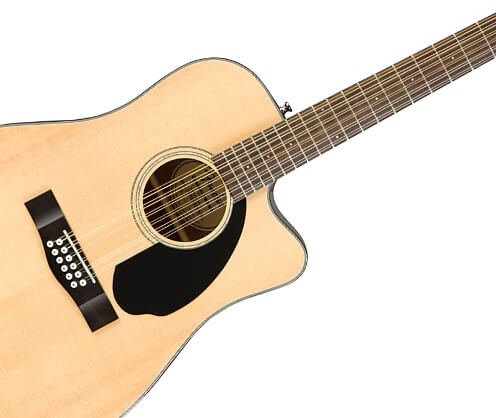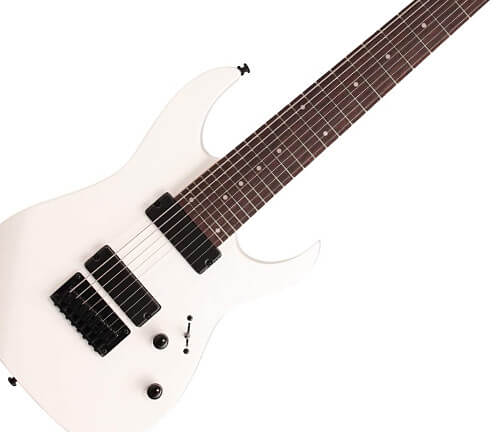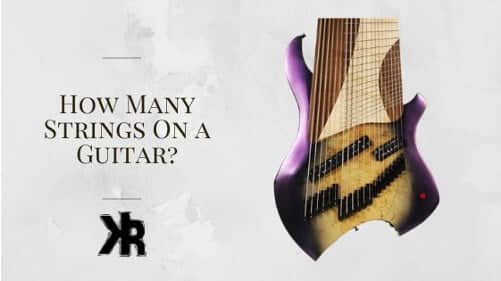Table of Contents
The guitar is an ever-evolving instrument! It changes each decade to meet the needs of musicians. Today, guitars come with many string configurations.
This allows for different playing styles and sounds. But with so many options, some players get confused. How many strings does a guitar have normally?
Six strings are the most common for electric and acoustic guitars. That’s because it allows for a good range of chords and melodies. All while being relatively easy to learn compared to any other variation.
In this Killer Rig article, we will look at the standard six-string guitar. We will explore its beginnings and touch on some of the newest variations and designs. We will also look at those with many more strings.
A Brief History Of The Guitar
The first six-string guitar was likely made in the 16th century and was called a Spanish vihuela. It had 6 double, or paired strings and was tuned like a lute. The vihuela was used primarily in Spain and Italy.
The modern 6-string acoustic guitar likely evolved from the Spanish vihuela. And it first appeared in the 18th century. It quickly became popular with composers and performers who appreciated its versatility.
The electric guitar was invented in the 1930s. It quickly rose to popularity in the 1940s and 1950s with the advent of rock ‘n’ roll. It, too, had 6 strings. And any models made through the decades have always been designed with this as the standard.
The Standard Six-String Guitar
The six-string guitar is the most popular and commonly found type. It usually has steel strings that are plucked or picked with the right hand. While the left-hand presses down on the fingerboard to create different notes.
The standard tuning for a six-string guitar is EADGBE. This allows for a good range of chords and notes.
They can be played without having to jump up and down the neck between points or frets. It’s also very comfortable for your hand and arm. This makes playing the instrument enjoyable.
You will find that acoustic and electric six-strings are the easiest to find. They are the standard when it comes to all guitars. Other models have been made with more strings. But a beginner should always start with the 6-string.
Why Only Six Strings?
There are many instruments with more than six strings. So why did early guitar designers settle on only six, you might ask? There are several good reasons:
- Tradition: The six-string guitar has been around for centuries! It has become the standard number of strings for the instrument. This is the first choice for guitar players and manufacturers and has stood the test of time.
- Playability: Six strings provide a wide range of notes and chords that can be played with ease. This makes it a versatile instrument that can be used in many different styles of music. It also allows for a wide range of techniques like intricate strumming and leads.
- Sound: In this form, it produces a rich, full sound! One that can be adjusted to suit different genres of music. The combination of different string gauges and tunings also increases the range easily.
- Cost and maintenance: Having the least number of strings makes it more affordable. It’s also easier to manufacture and maintain than guitars with more strings.
- Standardization: Six strings have become the standard for guitar manufacturers. And for good reason! This makes it easier for musicians to find and purchase guitars. But also for guitar teachers and students to learn the instrument.
Different Variations
As you will see, there are guitars with more strings. A lot more, too! But not every guitar needs them. And so it depends on the design and build, but the music it’s made for as well. Here are a few examples of popular styles.
Acoustic Guitars
The six-string acoustic guitar is the most popular. It’s also the most versatile, as it can be used for a variety of genres, including country, folk, rock, and pop.
If you are a beginner, we recommend starting with a standard six-string guitar. Once you have mastered the basics, you can move on to an acoustic guitar with more strings. There are a few different types of acoustic guitars that have more than six.
12-String

The most common is the 12-string acoustic guitar, which has 6 pairs. Each pair is placed close together and is picked or plucked as a single string would be. The sound produced is something like a chorus effect.
A portion of the string pairs is tuned an octave apart. The others are tuned to be identical in pitch. This type of guitar is often used for folk and country music and is a brilliant sound.
9-String
Another type of acoustic guitar is the 9-string. This guitar is less common and is usually only found in specialty stores. It has 3 pairs of strings that are tuned in octaves, plus 3 that are solely individual.
You could almost consider this guitar to be a hybrid of a 12 and a 6-string. You can find a 9-string guitar here at Furch.
The number of strings on an acoustic guitar is usually dependent on the type of music you want to play. So if you’re looking for an acoustic, you have a few options.
Electric Guitars
As we have touched on, the 6-string guitar is the most common, and this also applies to the electric. The standard tuning for an electric guitar is the same as an acoustic, which is EADGBE. This is standard tuning across most guitar types.
The 6-string electric guitar is most popular among rock, blues, punk, and metal musicians to name just a few. It allows you to amplify and even change the sound to get your desired tone.
7-String
A 7-string electric guitar has become more common and is used by a lot of guitarists. The 7th string is added to the bass side and is usually tuned to a low B. This opens up a whole new range of notes for you to play with.
This is considered to be an extended-range guitar, which is the first of a few options, as we will see.
8-String

An 8-string electric guitar is less common. But it’s slowly gaining popularity. It has 2 extra strings, which we find next to the low E. These are usually tuned to a low F# and a low B.
The 8-string guitar gives you a wider range of notes to play with. It also allows for some interesting chords that would not be possible on a 6 or 7-string. Popular metal music players also use different tuning arrangements for even more versatility.
9-String
The 9-string electric guitar is even less common! Even then the 8-string, and is more of a signature series novelty instrument. It has 3 extra strings, which are also added to the bass side.
The 9-string electric guitar gives you an even wider range of notes to play with. It also allows for some very interesting chords. But the addition of this new thicker string gauge can add buzz and noise! It can almost be considered a bass guitar.
10-String
The 10-string electric guitar is the rarest version. It has 4 extra strings, which really increase the possibilities of sound.
The 10-string electric guitar gives you a massive range of notes! It also allows for some very unusual chords. It’s not easy to play, but at any rate, it’s an option.
Other Multi-String Options
Other designs take it over the top and consist of 18 or even 20 or more strings. In these cases, the guitars are far too difficult to play and even tune and are more of a novelty item.
As you can see in this video, they can be played, but you will need to get creative!
Bass Guitars
The bass guitar is another design that uses a different number of strings. It’s not played like a six-string guitar, nor is it made to. But adding strings increases the range, which is great in some forms of music.
The bass guitar has strings that are pretty much twice as thick. It’s used for deep low frequencies, and adding strings increases this range. The standard bass comes with 4 strings and is tuned in standard E, A, D, and G.
You will also find some models with 5, 6, and even 7 strings that really provide a low tone! This can be used in many music genres, but there are limits! And as such, you will not really see more than 5 strings on a bass.
Multi Neck Guitars
These types of guitars have 2 or more necks and give the player more options. These can be any number of strings per neck that the player chooses for their musical style.
The most popular model is the Gibson EDS-1275. It has become iconic due to its use by many famous guitarists such as Jimmy Page, Slash, and Alex Lifeson.
What’s the Right Number Of Strings?
How many strings should a guitar have, is there a perfect number? The answer to this question is no. There is no right number of strings. This is completely personal preference. It all comes down to what you want to play and what feels comfortable for you.
If you are a beginner, then it’s probably best to start with a 6-string guitar. Once you develop more experience, you can then move on to a 7 or 8-string.
The bottom line is that it’s up to you to decide what feels right for your style. Many players only use 6-strings, while others use extended-range guitars.
FAQ
Is a 6-string guitar easier to play?
Yes. A 6-string guitar is easier to play. The addition of strings means there is more knowledge and technique required. A player will need to know how each additional string will need to be tuned and how to use them in chords.
There is also less information available when it comes to guitars with more than six strings. This is because it’s not the standard, which adds more complexity.
Is tuning a 12-string guitar hard?
When compared to a standard six-string guitar, it’s more difficult, yes. Only until you understand how the extra strings need to be tuned. Then it’s a lot easier and only requires additional time to tune it.
The nice thing about most of the strings is that they are only an octave higher than the fundamental. So this keeps it easy to understand.

